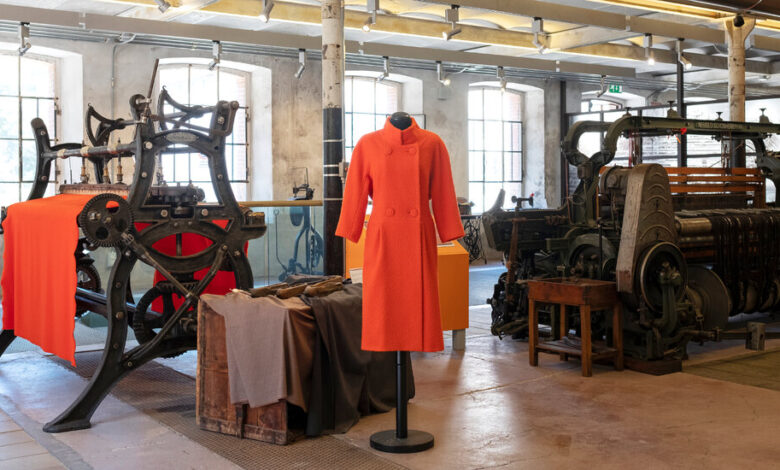Can an Iconic Italian Wool Survive a Changing Economy?

SOCI, Italy — For centuries, this remote and verdant valley in the heart of Tuscany has been known for its iconic “panno Casentino,” or “Casentino cloth,” the famously durable and waterproof wool made here.
The fabric has been equally popular among 14th-century merchants and Florentine lords, 19th-century composers — Verdi and Puccini among them — and movie stars known for their quintessential style, Audrey Hepburn topping the list.
Its production has survived all the transformations of Italy’s textile industry — from artisanal to large-scale industrial production, from the Golden Age of “Made in Italy” to its decline in favor of globalized, cheaper and faster fashion.
But now the only factory that makes the finished fabric from the coarse cloth may be facing one transition too many, as Italy’s instinct to preserve small-scale, niche manufacturers bumps up against the urgencies of the 21st-century digital economy.
This summer, the workers at the factory, Manifattura del Casentino, were told they would soon be evicted from their factory building, which was won in a 2018 auction by a real estate company owned by a large Italian web service provider, Aruba.
Aruba’s owners are originally from Soci, in the Casentino valley, and a few years ago bought a large textile mill in northern Italy and converted it into a data center. That factory was long closed, however.
If the factory here is forced to close, “It’ll be a debacle for the valley,” said Massimo Savelli, the 71-year co-owner of TACS, one of the two local Casentino clothing makers in Stia, a nearby village. “This cloth is unique in the whole world. No one can make it like they do.”
A spokeswoman for Aruba said that the purchase of the factory in Soci was still not finalized, and that Aruba itself had learned about the possible eviction of the workers only from news reports. Aruba was ready to forgo purchasing the building, she added, under the right conditions.
Yet the workers and those who depend on the cloth are nervous.
It is not the first time their livelihoods and traditions have been threatened. The workers have come to their factory’s rescue twice in the last 50 years, investing their savings and unemployment benefits to keep the business afloat and preserve jobs they see as part of history.
Today the cloth maker employs just 18 workers, and owns the factory’s machines, though not the premises, which went into the hands of liquidators after the workers’ cooperative that ran the mill went bankrupt in 2011. So the workers have taken up a new fight, seeking help from a local union to forestall eviction and involving the regional and national authorities who could have the final say on a legal dispute.
“This battle is not just for these 18 jobs,” Alessandro Mugnai, a leader of the CGIL union from the nearby city of Arezzo, told the workers at a recent meeting. “It is a battle of resistance. Because the factory is your job, but is also part of this community, like this cloth.”
The struggle to preserve the local traditions is emblematic of the titanic challenges faced by the small-scale manufacturers whose highly skilled craftsmanship allowed Italy’s fashion houses to garner international reputations.
The origins of the heavy Casentino cloth are lost in time. Wool was being made in the valley in the time of the ancient Romans. The valley’s water is abundant, thanks to the presence of two different tributaries of the Arno river, making the site especially suited to the wool’s production.
“The water here is so pure that it is perfect to mat and dye cloths,” said Francesca Filippi, a design contract professor at the University of Florence who has long studied textiles from Casentino, the area where she lives and grew up.
Attempts to make the fabric elsewhere have been second-rate. “Nowhere else the result is the same, the colors are duller and the curls more sparse,” she said.
Initially, the rough cloth was used to protect horses and was worn by cow and sheep herders who lived on one of Tuscany’s highest plateaus. But then it caught the eye of the merchants of Florence, a hub of the textile trade since the 14th century.
Soon it was so prized that Renaissance guilds mandated that it be made only with local wool, and a Medici grand duke forbade its sales outside the valley where it was produced.
Its dazzling, duck-beak orange color — originating from a dyeing mistake — became fashionable with Florentine nobility, while women opted for a bright green hue that was originally used for the coat linings.
In the 1800s, mechanical looms and other machinery arrived in the valley. Two wool mills were built adjacent to the two rivers, one in Stia and one in Soci. At the peak of production, the mills employed almost 850 workers.
The local fabric gained global attention when Audrey Hepburn donned an orange Casentino coat in the 1961 classic “Breakfast at Tiffany’s.” Gucci, Dolce & Gabbana and Givenchy have used the fabric in past collections.
“The cloth really is an emblem for our valley,” said Donatella Fani, a resident of Stia, sitting under the village’s portico where makers once dried and carded their wool. “This colonnade was built for that.”
For some families, Casentino cloth is part of their legacy.
Andrea Fastoni, 51, started working for the mill when he was 19. His mother was employed at the mill before him, and his memories as a child are of dozens of acquaintances working in the factory, and of the Ape cars, the Italian three-wheeled commercial vehicle, packed with bobbins of spun material and textiles, zipping around.
“Every garage in town had a loom or a warper. The mill had so much work that it was distributed across the community,” he said. “Now that it is the turn of my generation, I can’t let the mill go.”
The combination of a unique natural environment and local skills handed down for generations make moving the factory impossible, the workers say.
“In these curls, there is a culture, a knowledge that generations have perfected,” said Roberto Malossi, 54, touching the orange cloth that is typically used for the area’s classic winter coats.
It is also thanks to these thick curls that the Casentino coats are warm and water-repellent, without the addition of insulation.
Mr. Malossi now owns Manifattura del Casentino. But he prefers to call himself the mill’s “first worker,” because the employees consider themselves a family.
Mr. Malossi pointed to a basin just outside the factory, where clear water gushed from a centuries-old canal that comes down from the mountains.
“Building another canal is impossible these days,” he said. “And we have millions of euros’ worth of pipes and tubes underground and around the walls to carry steam or gas. Nobody has the money to build such a system nowadays.”
It only adds to the workers’ chagrin that in recent months the company was recovering. After two disastrous years during the Covid-19 pandemic, it has seen its orders triple as supply chain turmoil and rising transportation costs spurred many Italian brands to veer toward local production.
Mr. Savelli, the cloth maker in Stia, said that business had increased by 20 to 30 percent this year, and that shipments were ready for a number of international markets, including Asia.
Another local manufacturer, Claudio Grisolini, was preparing to introduce a Casentino collection entirely made in Italy, from the wool to the spinning and the final product, reversing a century-long habit of buying wool from Australia or New Zealand. If the mill closes, the project he has worked on for years will be at stake, he said.
On a recent afternoon at the mill in Soci, workers checked the bright orange woolen cloth that moved slowly through an imposing machine which, running in elliptical circles, created little curls on the fabric. It was a place where time seemed to have stopped.
“What we do is historical; this factory has seen seven generations of workers,” Antonella Ghini, 53, who has worked there for 18 years, said with her arms crossed during a union meeting. “I don’t want it to end with me.”



